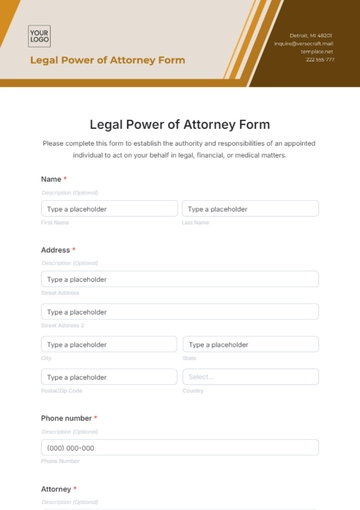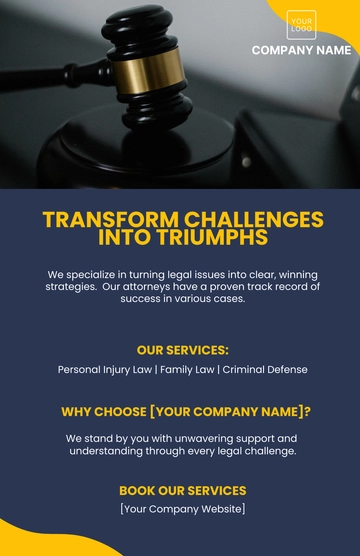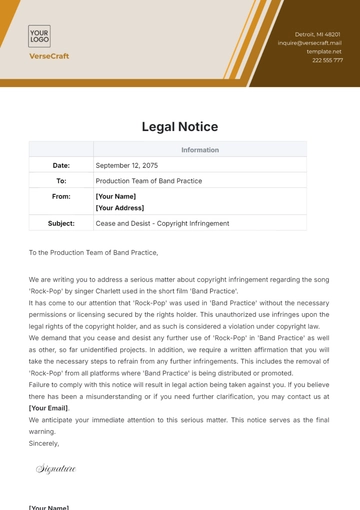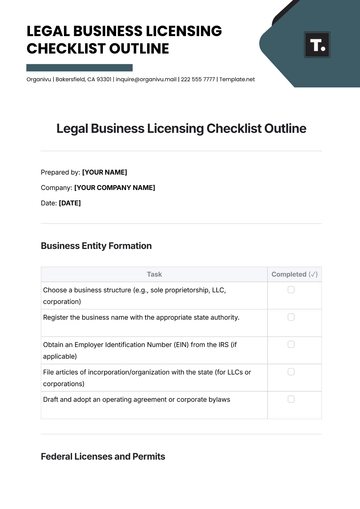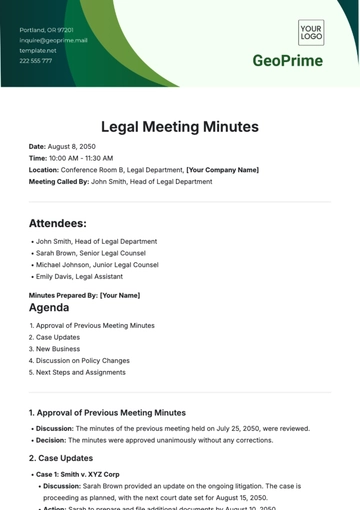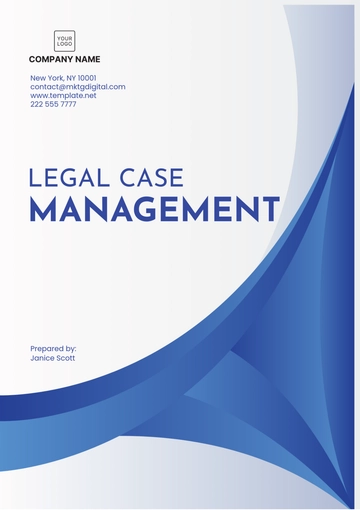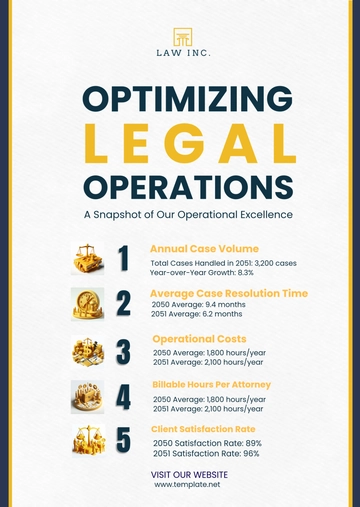Free Law Firm Growth Strategy

I. Market Analysis and Segmentation
To enhance [Your Company Name]'s footprint, an in-depth market analysis is essential. This analysis will identify potential new markets and understand the legal needs specific to these regions. Identifying underserved areas or industries where specialized services can be marketed is key to setting a focused growth trajectory.
Delving into market segmentation allows for a targeted approach, ensuring resources are allocated efficiently. By categorizing clients based on demographics, industries, or legal needs, [Your Company Name] can tailor its services effectively. Furthermore, understanding the competitive landscape in each segment provides valuable insights for positioning [Your Company Name] as a leader in specialized legal services.
Harnessing data-driven insights enables [Your Company Name] to identify emerging trends and anticipate future market demands. This proactive approach positions the firm to capitalize on new opportunities and stay ahead of competitors. By continually refining its market analysis and segmentation strategies, [Your Company Name] ensures sustained growth and remains at the forefront of the legal industry.
II. Client Acquisition Strategies
The success of the firm hinges on not just attracting but also retaining a diverse client roster. Strategies will include improving online presence, strengthening referral networks, engaging in strategic partnerships, participating in industry conferences, and targeted advertising.
Improving Online Presence: Enhancing [Your Company Name]'s website and utilizing digital marketing channels such as SEO, content marketing, and social media to increase visibility and attract potential clients.
Strengthening Referral Networks: Cultivating relationships with existing clients, industry peers, and professionals in complementary fields to generate referrals and recommendations.
Engaging in Strategic Partnerships: Collaborating with other businesses or organizations whose clientele align with [Your Company Name]'s target market to expand reach and access new client pools.
Participating in Industry Conferences: Attending and speaking at relevant conferences, seminars, and networking events to establish credibility, build relationships, and showcase expertise within specific legal sectors.
Targeted Advertising: Utilizing targeted advertising campaigns across digital and traditional channels to reach specific demographics or industries, maximizing ROI and generating qualified leads.
Implementing a combination of these strategies will not only amplify [Your Company Name]'s reach and brand visibility but also foster long-term client relationships and sustainable growth. By continuously evaluating the effectiveness of each strategy and adapting to evolving market dynamics, the firm ensures a competitive edge in client acquisition and retention.
III. Technology Integration
Embracing technology will streamline operations, enhance case management, and improve client interactions. Investing in technology such as AI for legal research, client management software, and secure communication platforms will ensure efficient service delivery and client satisfaction.
AI for Legal Research: Implementing AI-powered tools for legal research enhances the speed and accuracy of information retrieval, allowing [Your Company Name] to provide thorough and timely counsel to clients.
Client Management Software: Adopting advanced client management software facilitates organization, communication, and collaboration, streamlining workflows and enhancing transparency throughout the client lifecycle.
Secure Communication Platforms: Utilizing encrypted communication platforms ensures confidentiality and security in client interactions, fostering trust and compliance with data protection regulations.
Support for Remote Work Environments: Technology integration enables [Your Company Name] to embrace remote work setups, empowering staff to work efficiently from anywhere and expanding access to a global talent pool.
By leveraging technology integration, [Your Company Name] not only enhances operational efficiency but also adapts to evolving client expectations and industry standards. This strategic approach fosters innovation, agility, and resilience, positioning the firm for sustained success in a rapidly changing legal landscape.
IV. Service Innovation
Service innovation will encompass developing new legal services that align with evolving market needs and regulatory landscapes. Regularly assessing and adjusting the service portfolio will ensure relevance and competitiveness in the market.
Market Needs Assessment: Conducting thorough market research to identify emerging trends, client pain points, and regulatory changes, informing the development of innovative legal services.
Agile Service Portfolio Management: Implementing a flexible approach to service portfolio management allows [Your Company Name] to adapt quickly to changing market dynamics and client demands.
Specialized Focus Areas: Special attention will be given to emerging fields such as environmental law, intellectual property rights, and international business law, where demand is growing due to evolving regulatory frameworks and globalization trends.
By prioritizing service innovation, [Your Company Name] remains at the forefront of the legal industry, offering tailored solutions that address the evolving needs of clients and differentiate the firm in a competitive market landscape.
V. Client Relationship Management
Enhancing client relationships is paramount. This will be achieved through personalized service offerings, regular feedback mechanisms, client satisfaction surveys, and loyalty programs. Priority will be given to understanding client needs and tailoring services accordingly.
Strategies | Description |
|---|---|
Personalized Service Offerings | Tailoring legal services to meet the unique needs and preferences of each client, ensuring a personalized and bespoke experience. |
Regular Feedback Mechanisms | Implementing systems for collecting and analyzing feedback from clients regarding their experiences with [Your Company Name], enabling continuous improvement. |
Client Satisfaction Surveys | Conducting periodic surveys to assess client satisfaction levels, identify areas for enhancement, and measure the effectiveness of service delivery. |
Loyalty Programs | Establishing loyalty programs to incentivize repeat business and foster long-term relationships with clients, offering exclusive benefits and rewards. |
Understanding Client Needs | Prioritizing comprehensive understanding of client objectives, challenges, and expectations to provide tailored legal solutions and exceed client expectations. |
By implementing personalized service offerings, [Your Company Name] ensures that clients receive tailored legal solutions that meet their specific needs and preferences. Regular feedback mechanisms, including client satisfaction surveys and ongoing communication channels, enable [Your Company Name] to continually assess and improve its service delivery. Additionally, loyalty programs incentivize repeat business and demonstrate appreciation for client loyalty, contributing to long-term relationships and mutual success.
VI. Professional Development and Training
Investing in continuing education and professional development ensures that the team is not only proficient but also ahead of industry trends. Training programs will focus on legal skills, client communication, and technology usage. Regular performance reviews and career planning sessions will also be implemented to assist staff in their professional growth.
Strategies | Description |
|---|---|
Continuing Education Programs | Offering ongoing training and development opportunities to enhance legal knowledge, skills, and expertise, ensuring [Your Company Name]'s team remains up-to-date with industry advancements. |
Client Communication Workshops | Conducting workshops and seminars to refine client communication skills, including active listening, effective questioning, and empathetic engagement, to improve client satisfaction and relationships. |
Technology Training Initiatives | Implementing training initiatives focused on utilizing and optimizing technology tools and platforms relevant to the legal profession, enhancing efficiency, and staying competitive in a digital landscape. |
Performance Reviews | Conducting regular performance reviews to assess individual and team performance, provide constructive feedback, and identify areas for improvement and growth, fostering accountability and excellence. |
Career Planning and Development | Facilitating career planning sessions and opportunities for professional growth and advancement, including mentorship programs and skill-building workshops, to support staff in achieving their long-term career goals. |
By offering continuing education programs, including workshops on client communication and technology training initiatives, the team remains proficient and adaptable in an ever-evolving industry. Regular performance reviews and career planning sessions further empower staff to excel in their roles, fostering a culture of continuous improvement and excellence.
VII. Geographic Expansion Plans
Geographic expansion is a pivotal element of this growth strategy. The plan will initially focus on national expansion before taking on international markets. We will evaluate potential regions for expansion based on client demand, market stability, and legal specificities.
Strategies | Description |
|---|---|
National Expansion Strategy | Developing a comprehensive strategy for expanding [Your Company Name]'s presence within national borders, targeting regions with high client demand and growth potential. |
International Market Assessment | Conducting thorough assessments of international markets to identify opportunities for expansion, considering factors such as market stability, legal frameworks, and cultural nuances. |
Client Demand Analysis | Analyzing client demand and preferences in target regions to tailor expansion efforts and services accordingly, ensuring alignment with market needs and maximizing growth potential. |
Legal Specificities Evaluation | Assessing legal specificities and regulatory environments in potential expansion regions to mitigate risks and ensure compliance with local laws and regulations. |
Market Stability and Risk Management | Evaluating market stability and potential risks associated with expansion efforts, implementing risk management strategies to minimize adverse impacts and safeguard [Your Company Name]'s interests. |
By strategically focusing on national expansion initially and conducting thorough assessments of international markets, we ensure a systematic approach to expansion. Analyzing client demand, legal specificities, and market stability enables us to identify viable opportunities and mitigate potential risks effectively. This strategic expansion plan aligns with [Your Company Name]'s growth objectives and positions the firm for sustainable success in both domestic and international markets.
VIII. Marketing and Brand Positioning
Effective marketing and clear brand positioning are vital. The marketing strategy will include digital marketing, public relations efforts, educational webinars, and whitepapers to showcase expertise. A refined brand message that communicates reliability and specialization will be consistent across all platforms.
Strategies | Description |
|---|---|
Digital Marketing Campaigns | Implementing targeted digital marketing campaigns across various platforms to increase brand visibility, generate leads, and engage with the target audience. |
Public Relations Initiatives | Executing public relations campaigns to enhance [Your Company Name]'s reputation, establish thought leadership, and cultivate positive media coverage. |
Educational Webinars and Whitepapers | Hosting educational webinars and publishing whitepapers to demonstrate expertise, share industry insights, and provide valuable resources to clients and prospects. |
Consistent Brand Messaging | Developing a refined brand message that conveys reliability and specialization, ensuring consistency across all marketing materials and communication channels. |
By leveraging digital marketing, public relations efforts, and educational content, we aim to enhance brand awareness and establish [Your Company Name] as a trusted authority in the legal industry. A consistent brand message that communicates reliability and specialization reinforces our commitment to delivering exceptional service and strengthens our position in the market.
IX. Networking and Industry Presence
Increasing our presence in relevant legal circles will be achieved through memberships in legal associations, speaking engagements, and publishing articles in respected legal journals. Networking with other legal professionals and businesses will foster referrals and strategic partnerships.
Strategies | Description |
|---|---|
Membership in Legal Associations | Joining relevant legal associations and organizations to network with peers, stay updated on industry trends, and access professional development opportunities. |
Speaking Engagements | Securing speaking opportunities at industry events, conferences, and seminars to showcase expertise, share insights, and enhance [Your Company Name]'s visibility. |
Publishing Articles | Writing and publishing articles in respected legal journals, blogs, and publications to demonstrate thought leadership and contribute valuable insights to the legal community. |
Networking with Legal Professionals | Actively engaging in networking events, meetings, and forums to connect with other legal professionals, exchange referrals, and explore potential collaboration opportunities. |
Enhancing [Your Company Name]'s presence in relevant legal circles is essential for fostering connections, building credibility, and expanding our network. Through strategic initiatives such as joining legal associations, securing speaking engagements, and publishing articles, we position ourselves as thought leaders and trusted advisors in the legal industry. Networking with peers and businesses further strengthens our relationships and opens doors to valuable opportunities for referrals and strategic partnerships.
X. Financial Management and Sustainability
Robust financial planning and management are crucial for sustainable growth. This will involve careful budgeting, financial forecasting, and resources allocation. Optimizing operational costs while investing in growth areas will maintain financial health and support strategic initiatives.
Strategies | Description |
|---|---|
Budgeting and Financial Forecasting | Implementing thorough budgeting processes and financial forecasting methods to anticipate future expenses, revenues, and cash flow, enabling informed decision-making. |
Resource Allocation | Strategically allocating resources, including funds, manpower, and time, to prioritize initiatives that align with [Your Company Name]'s growth objectives and strategic priorities. |
Operational Cost Optimization | Identifying opportunities to streamline operations, reduce overhead costs, and improve efficiency without compromising quality or service delivery standards. |
Investment in Growth Areas | Allocating resources towards growth areas and strategic initiatives, such as technology integration, talent development, and geographic expansion, to drive sustainable growth. |
Maintaining [Your Company Name]'s financial health and sustainability requires a proactive approach to financial planning and management. By implementing robust budgeting processes, optimizing operational costs, and strategically allocating resources, we ensure that financial resources are utilized efficiently and effectively. Moreover, investing in growth areas supports [Your Company Name]'s long-term objectives and fosters sustainable expansion and success in the legal industry.
XI. Performance Metrics and Continuous Improvement
To measure the effectiveness of the growth strategy, clear performance metrics will be established. These will include client acquisition rates, client retention percentages, financial targets, and employee satisfaction rates. Regular reviews will be conducted to assess progress and make necessary adjustments to the strategy.
Performance Metrics | Description |
|---|---|
Client Acquisition Rates | Tracking the number of new clients acquired within a specific period to evaluate the effectiveness of client acquisition strategies. |
Client Retention Percentages | Monitoring the percentage of clients retained over time to assess client satisfaction, loyalty, and the effectiveness of retention efforts. |
Financial Targets | Setting and monitoring financial targets such as revenue growth, profit margins, and return on investment to gauge financial performance. |
Employee Satisfaction Rates | Conducting surveys or assessments to measure employee satisfaction levels, engagement, and retention, reflecting the effectiveness of internal policies and practices. |
Establishing clear performance metrics allows [Your Company Name] to assess the progress and impact of the growth strategy objectively. By regularly reviewing and analyzing these metrics, we can identify areas of success and opportunities for improvement, enabling continuous refinement and optimization of the strategy. This commitment to performance measurement and continuous improvement ensures that [Your Company Name] remains agile, responsive, and competitive in the legal market.
In conclusion, [Your Company Name]'s comprehensive growth strategy encompasses market analysis, client acquisition, technology integration, service innovation, client relationship management, geographic expansion, marketing, financial management, performance metrics, and continuous improvement. By strategically implementing these initiatives, [Your Company Name] aims to solidify its position as a leader in the legal industry, drive sustainable growth, and deliver exceptional value to clients and stakeholders alike.
- 100% Customizable, free editor
- Access 1 Million+ Templates, photo’s & graphics
- Download or share as a template
- Click and replace photos, graphics, text, backgrounds
- Resize, crop, AI write & more
- Access advanced editor
Dive into strategic planning with Template.net's Law Firm Growth Strategy Template. This robust, customizable blueprint is incredibly user-friendly and fully editable in our Ai Editor Tool. Set your law firm up for exponential growth as you adapt and implement effective marketing strategies. Aim bigger, streamline your processes and build a formidable legal empire with our reliable, professional-grade templates. Your law firm's success story begins here. Welcome to growth made easy with Template.net.
